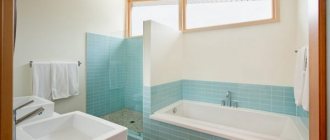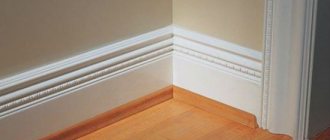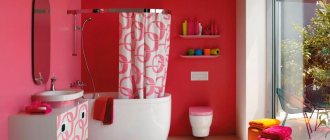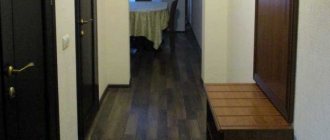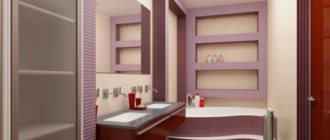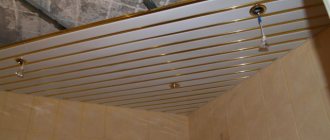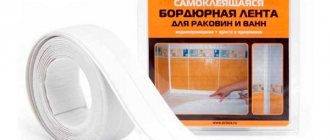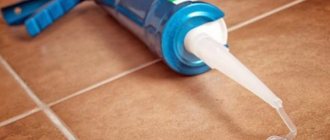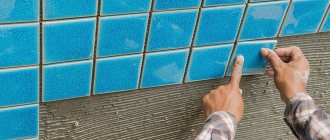The importance of a water heated towel rail in the bathroom cannot be underestimated - it not only performs the task of drying clothes, but also reduces the humidity in the room. This reduces moisture condensation and the risk of harmful mold and mildew forming on walls, floors and ceilings.
When choosing a coil, attention is paid to its design and shape. But do not forget that the location must be thought out in advance. The optimal installation height for a heated towel rail is 120 cm . But you should remember a number of additional conditions!
Correctly chosen height by the developer at the stage of installing plumbing will allow apartment owners to enjoy the convenience and comfort of the equipment. What problems can arise from ignoring recommendations - read on!
Main types of dryers
Different types of coils differ in shape and material from which they are made. Products made of stainless steel have a long service life. Their surface is not coated with additional coating, but is simply polished to a shine, thereby creating an attractive appearance.
As for brass and chrome-plated products, the service life varies from 5 to 10 years, after which replacement will be required.
We advise you to choose heated towel rail models that do not have jumpers or connecting seams.
, the diameter of the pipes and the shape of the dryer structure are important . Among the most common forms:
- snake;
- ladder;
- U-shaped.
on the shape and design features , which is prescribed in the standard for household consumers .
Heated towel rail placement options
The heated towel rail is placed taking into account 2 factors. It must work fully, especially for devices connected to the heating system or hot water supply. The second requirement is convenient access to the top rail of the dryer. Special conditions apply to electrical devices connected to an outlet. The connection point must be in a safe place at a distance of at least 60 cm from the bathtub or sink.
The water device is tied to the pipes next to which it is placed. If space is limited, you may find that you need to install a heated towel rail above the bathtub or sink. It is inconvenient to use, but sometimes you have to use this option. Water splashes on the towel and the bath makes it difficult to reach it.
The most convenient place is above the washing machine, regardless of the type of equipment. Consider the location of the mirror and furniture for storing towels so that they are located close to the unit. It is not recommended to choose a wall above the toilet - just an awkward movement and the towel will end up in the plumbing.
The water device is inserted in such a way that hot water is supplied through the upper pipe, and the outlet is located below. With this connection method, the towel is placed in a convenient place at any distance from the riser. Other insertion methods are possible, but in order for the coil to work, installation rules must be followed.
Installation rules
Installation of a coil involves inserting a supply pipe into a hot water supply or heating system.
Tools you will need for the job:
- minus screwdrivers;
- pliers;
- mounting bracket;
- pipe cutter and polypropylene pipes;
- fitting;
- Ball Valves.
The most rational way is to tap into the hot water supply system , since hot water is available in our houses and apartments all year round. Installation can be divided into several required steps:
- dismantling the old coil;
- pipe welding;
- installation of two taps;
- jumper installation;
- fixing the ball valve to the bypass.
Pay attention to the last point : its implementation makes it possible to adjust the operation of the heated towel rail, regardless of how far from the floor or above the washing machine it will be fixed.
Before starting installation work, it is mandatory to write an application to the housing office (ZhES) in order to agree on the date and time of shutting off the water in the riser.
Depending on the chosen installation option, connecting pipes made of different materials can be used :
- Copper is a rather expensive and complex option that requires the use of special equipment for soldering.
- Polypropylene is the most popular and affordable option due to its cost. It has high stability and durability.
- Metal-plastic - a budget option. For fixation, a crimping method is used, so the material may not be resistant to pressure changes in the heating system.
We recommend that you familiarize yourself with the visual video instructions:
Features of installation of different types of heated towel rails
Heated towel rails differ in the heating method: water, electricity or a combination of both. Each type of connection has its own characteristics.
Water
The device is heated by water that circulates through it. The connection is made by tapping into water supply or heating pipes. In the first option, the device dries; if water is consumed, it cools down overnight. This is a disadvantage of such a scheme. With the second method, the unit is warm around the clock, but only during the heating season.
Connection diagrams depend on the design of the model and its location relative to the riser. For equipment made in the form of a coil, a side insert is used on either side. No additional pipelines are required; installation after finishing work does not damage the walls.
The system operates subject to the following conditions:
- A position is found for the device so that the coolant inlet is above the connection point, and the outlet is below. Maintain the slope of the supply pipelines: 2 cm per 1 linear line. m.
- The connecting pipes do not have bends, otherwise air pockets will form. Thermal insulation is desirable.
- Standard for leads: diameter of steel ¾”, polypropylene – 25 mm.
In the side circuit, a bypass is often used - a jumper between the supply pipes. It can be from a pipe whose diameter is 1 step smaller. The coolant must be supplied from above. You can install taps on the device pipes to shut off the coolant supply. This allows you to turn off the device for repairs without stopping the operation of the heating system or hot water supply.
The lower inset is used mainly for ladder-type models. Both device connection points are located at the bottom. The heated towel rail is placed so that they are located above the insertion point. Maintain a slope of the supply pipes of 2 cm by 1 m, then the direction of the water flow does not affect the performance of the device.
Equipment operating on water is installed taking into account the requirements:
- The diameter of the device pipes cannot be narrower than the supply pipes.
- It is forbidden to install shut-off valves on the bypass and in front of it - the circulation and pressure in the system of the entire house are disrupted. The place for its installation is after the jumper.
- The distance from the device to the wall is at least 3.5 cm when the diameter of its pipes is up to 2.5 cm. If it is greater, the distance is increased to 5-7 cm.
It is not allowed to install the device below the return pipe with coolant. The water sinks and does not push further, unable to overcome the pressure from above. There is no circulation, so the device does not dry. An option that leads to a similar result is if they try to hide the hot water supply behind the ceiling, and the cold water supply under the floor. An air lock forms in the upper pipe, stopping the coolant circulation.
Electric
It is easier to install an electrical device; pipes do not affect the placement. Height also does not matter much, but maximum attention is paid to safety. The main thing is where the connection point is located, and not the device itself.
The socket, if installed in the bathroom, must be IP44 class - with a cover on a waterproof housing and seals at the cable inlet. It is not mounted on a cold wall, where condensation accumulates, which can lead to a short circuit.
Distance:
- from the bathtub, sink - at least 60 cm;
- to the floor - at least 20 cm;
- to furniture - 75 cm.
The drying device is placed away from the outlet so that it does not cover it with the housing.
In the second, safer method, the connection point is taken outside the bathroom.
Electrical wiring must comply with operating conditions in a room with high humidity:
- a three-core copper cable VVGng or VVGng-LS is used;
- grounding is required;
- install an RCD.
The wiring should preferably be hidden; walls are tapped for the cable. You can use a corrugated hose or sleeve, but only a plastic one; metal products are prohibited.
Combined
Combined units are connected to water and electricity. Heat sources are used independently.
This is a plus of such systems, because:
- energy is saved during the heating season;
- in summer they are turned on if necessary;
- rapid heating is ensured by the heating element.
The models come in a variety of shapes and colors and fit into any interior.
Double connections require precise calculation of the height and distance to the pipes. Installation is carried out taking into account the requirements for water and electric heated towel rails. The optimal height above the floor is 1 m.
A bypass and shut-off valves must be installed on both pipelines. Heating by the heating element is controlled by a thermostat.
Installation according to SNiP
Standards have been developed that take into account the correct arrangement of elements in the bathroom.
The mounting height of the heated towel rail (with or without a shelf) is clearly indicated in SNiP 2.04.01-85 (internal sanitary systems): the distance from the bottom of the M-shaped device to the floor must be at least 90 cm, U-shaped ones are installed at least 120 cm from the floor .
Check out the full list of rules:
Internal water supply and sewerage of buildings
Additional installation rules must also be taken into account:
- We recommend installing an electric heated towel rail above the washing machine. Be prepared that this will require moving the machine or sink. But this will allow you to get comfortable and convenient operating conditions.
- If you have a front-loading washing machine (loading laundry from above), the lid should not rest against the coil when opened.
- The edge of the rosette or reflectors should not interfere with decorative panels or decorative elements of the room.
- The height and width of installation of the dryer on the wall must be such that it is at least 60 cm from the sink, bathtub, shower or other equipment.
Four simple rules ensure complete safety and long-term operation of the equipment. Additional graphic information:
Heated towel rail installation height
Special requirements apply to the installation height of the heated towel rail. They take into account the optimal heat transfer of the heater and ease of use. The installation height of the heated towel rail according to SNiP is 120 centimeters from the floor level. In addition, the regulations require that the washing machine be installed under a heater. At the same time, a top-loading machine should not touch the pipes. The collapsible unit is located at least 60 centimeters from it.
It happens that the installation height of a heated towel rail cannot be maintained for various reasons. Therefore, there are general recommendations for installing equipment. They allow you to install the structure no lower than 95 centimeters from the floor level and no higher than 170 to provide convenient access to the upper part. How to properly install the equipment is shown in the video
When independently connecting a heater to a hot water or heating system, you need to carefully study the regulatory documents, watch the installation video course and familiarize yourself with the installation diagrams in the pictures. Particular attention should be paid to the installation height of the heated towel rail according to SNiPs
Additional installation options
Even with every desire, it is not always possible to take into account the standards and requirements of SNiP in design projects. This may also be due to the presence of a multi-level floor in a small room. We advise you to follow simple rules:
- The location of the dryer in the bathroom is from 95 to 170 cm . You need to choose a distance to the floor so that an adult can comfortably use the device.
- When installing a ladder coil, a person must reach its top rung.
- M-shaped coils are attached at least 90 cm, U-shaped coils at least 110 cm.
These simple rules will help you carry out installation work with your own hands in the shortest possible time.
How the coil is attached
Installation of the heated towel rail step by step with all fittings is as follows.
- Markings are applied to the working wall in order to install the brackets evenly.
- Holes for dowels are prepared according to the markings.
- The next step is to attach all the brackets to the dryer, and then screw them to the work area using screws.
- The final step is to connect the device to the necessary valves using fittings. All connections must be sealed with linen winding.
If you are installing a heated towel rail in the bathroom with your own hands, then it is worth considering that straight and corner fittings can be used, depending on what type of connection is used in this case.
Installing an electric heated towel rail according to the rules - notes for the home handyman
Electric heated towel rail in the bathroom
How to connect an electric heated towel rail so that you don’t have to worry about the safety of the residents of your apartment and don’t bypass this device? The answer to this question is simple.
To do this, you must comply with the rules of the PUE, as well as basic safety standards during installation. And so that you don’t have any problems with this, in our article we will describe in detail not only the connection process itself, but also cover all the related issues.
Differences between heated towel rails
But before proceeding directly to the issue of installation, let's look at the features that different models have and what impact they will have on the installation process.
| Power of electric heated towel rails | One of the main parameters is power. We need knowledge of this parameter to select electrical installation devices, such as: socket, RCD circuit breaker, group circuit breaker, to determine the required wire cross-section, as well as to determine the possibility of connecting this device to an already existing network (see How to choose an electric heated towel rail). |
| Mobile heated towel rail | The next important factor is the type of heated towel rail. This may be a stationary installation, or it may be a device that differs from a mobile oil radiator only visually. |
| Heated towel rail with hidden wiring | You should also immediately decide on the type of connection. There are electric heated towel rails with hidden wiring and with a wire and plug exposed for connection. The former are connected in a hidden way directly to the electrical network, while the latter are connected to any nearby outlet. |
General rules for connecting heated towel rails
Having decided on the basic parameters important for proper connection, we move on to selecting materials and choosing the location for installing the heated towel rail. These rules are the same for all types, so we have combined them in this section.
- First of all, we need to know whether we can connect a new electrical installation to an existing network. To do this, we need to know its power, which can then be easily converted into rated current.
- To do this, we use Ohm's law. According to which current is equal to power divided by voltage. We know the power, let’s say 1500W, and the voltage in our outlet is 220V. That is, for this heated towel rail the rated current will be approximately 7A.
Single-pole group circuit breaker for 16A
- Group circuit breakers in your apartment usually have a rated current of 16 or 25A. And an additional 7A will be a significant increase. Therefore, we need to calculate whether our network can withstand such an increase. To do this, it is necessary to calculate and summarize the rated current of all electrical appliances in a given group network that can operate simultaneously. And if the resulting value is higher than the nominal parameters of group machines, then it is better to create another group network, to which only our heated towel rail will be connected.
- The next important parameter is the choice of wire. As the instructions say, it must be a copper wire with a cross-section of at least 1.0 mm2. This is exactly the value that the PUE sets for the wires of the group network.
- In our case this is enough. But if you are installing a more powerful heated towel rail, then you should make your choice according to the table. 2.3.2 PUE.
Table for selecting wire cross-sections
- Now, regarding the installation location of the heated towel rail. According to the PUE standards, the entire bathroom is divided into 4 zones and the installation of electrical appliances with IPx5 is allowed only in zones 2 and 3. This zone is located at a distance of more than 60 cm from the edge of the sink, bathtub or shower.
The photo shows electrical safety zones in the bathroom
Note! The same rule applies to sockets. Therefore, if you need to place an outlet in the bathroom, it should also be located at a distance of no closer than 60 cm from the above locations.
Installation of electric heated towel rails
Now you can proceed directly to installation. Since electric heated towel rails with hidden wiring have some installation features, unlike their counterparts with a wire and plug, we will consider them separately (see Connecting electric heated towel rails).
Is it possible to hang a heated towel rail above a washing machine?
In small rooms, every centimeter counts, so sometimes it is necessary to install the device above the washing machine; there is simply no other place. This arrangement of the heated towel rail may be unsafe. Therefore, you need to retreat at least 60 cm from the surface of the device. Otherwise, there will be a risk of fire due to overheating. But even if a fire does not happen, prolonged exposure to high temperatures (60 degrees and above) will negatively affect the operation of the machine. This is especially true for front-loading devices, the open lid of which will touch the heated towel rail. Also, drying things will create increased humidity, which will lead to corrosion of the machine.
The Praktika online store offers electric and water heated towel rails from trusted manufacturers. The range includes models for small and spacious bathrooms. Request a call back to get advice from a manager and discuss delivery conditions in St. Petersburg or the Leningrad region.
How to install a heated towel rail correctly?
There is no need to use your imagination; there are SNIP requirements according to which a heated towel rail must be installed in the bathroom. First you need to figure out the installation height of the product. According to standards, the distance from the floor should be at least 120 cm. But design projects often conflict with these requirements. In the bathrooms of apartment buildings with a standard ceiling height, it is difficult to place a large heated towel rail without violating any requirement. Therefore, it is allowed to deviate slightly from the norms, focusing on the shape of the product. For U-shaped models, the minimum height for installing a heated towel rail is 110 cm; M-shaped models are hung at least 90 cm from the floor. It is not recommended to install the product above 170 cm, because then it will be difficult to reach the upper crossbars.
Often deciding at what height to hang a large heated towel rail comes down to convenience. For example, devices in the form of a ladder can have a length of 100 cm. In this case, it is impossible to retreat the required 120 cm; few people will like drying towels under the ceiling. By the way, the distance to the ceiling is also standardized; it is recommended to leave 50 cm. Therefore, if necessary, deviations from the given figures are possible.
The quality of heating of the room also depends on the installation height of the heated towel rail. Hot air goes up, so if the location is too high at the bottom, the temperature will not be very comfortable. This is especially true for electrical equipment, which is not as good at heating as water options.

